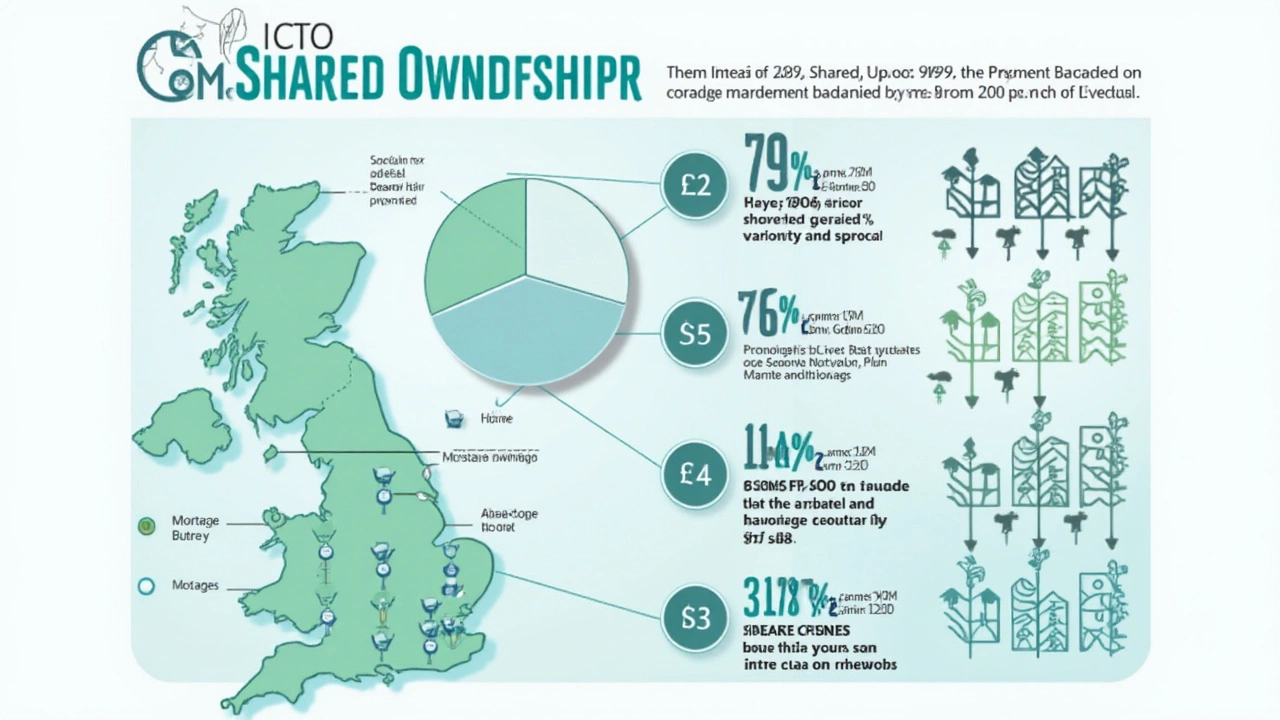Understanding Share Ownership Structures in Shared Ownership Homes
 Jan, 31 2025
Jan, 31 2025
Shared ownership homes represent an intriguing avenue for those eager to step onto the property ladder, especially in bustling cities where buying a home outright might often seem like a distant dream. These schemes allow buyers to purchase a portion of a property, while a housing association or another entity owns the remaining share.
Understanding how these ownership splits work can be crucial for anyone considering this route. Not only does it provide a feasible way to secure a home, but it also presents unique financial opportunities and obligations. Discover how this system functions, its advantages, and potential pitfalls to better equip yourself for the journey into shared ownership.
- Introduction to Share Ownership
- How Shared Ownership Works
- Benefits of Shared Ownership
- Financial Implications
- Tips for Potential Buyers
Introduction to Share Ownership
As the world of real estate continuously evolves, new avenues for homeownership emerge, each marked by their own set of rules and benefits. Shared ownership is one such imaginative approach that has been increasingly gaining traction amidst rising property prices, particularly in urban hubs like Sydney. At its core, shared ownership allows individuals to purchase a portion of a property, offering a practical solution for those who may not yet be able to buy a house outright.
The concept is simple yet revolutionary: potential buyers purchase a percentage of a property, typically ranging from 25% to 75%, with the option to increase this share over time—a process known as 'staircasing.' The remaining portion of the home is typically owned by a housing association or sometimes a private developer. For the share that one doesn't own, a subsidized rent is paid, often making this route more affordable than traditional home ownership or renting in the long term.
Now, what makes shared ownership appealing to a wide range of buyers, beyond the evident financial advantages, is the flexibility it provides. It’s a tailored approach, allowing buyers to purchase more shares as their financial situation improves or when they feel the market is right. According to the HomeFreeUSA survey, "87% of shared ownership tenants plan to increase their ownership stakes within the first five years." This hybrid model gives people the confidence that they can gradually increase their investment in their home, even as life circumstances ebb and flow.
For those dabbling in the shared ownership market, one key point to understand is the legal arrangement involved. Buyers aren't classified as full freehold owners but rather leaseholders with a lease typically lasting 99 or even 125 years. This lease length provides ample time for families to grow and settle, offering both stability and long-term security. Yet, it’s crucial to carefully scrutinize the terms laid out in the lease agreement, such as exemptions, staircasing limitations, and resale processes to ensure it aligns with your future plans.
Shared ownership is not without its critics, though. Some argue that the dual nature of paying a mortgage alongside rent could pose challenges as both financial commitments are subject to their respective market conditions. Nevertheless, the scheme offers a pragmatic advantage for those looking to make their dream of home ownership a reality sooner rather than later. By entering the housing market with less capital investment upfront, shared ownership might just be the stepping stone needed to ascend the property ladder in a bustling real estate market.
How Shared Ownership Works
Shared ownership is a scheme designed to provide a middle ground between renting and full homeownership, particularly beneficial for those keen to take the first step into the property market without the overwhelming burden of purchasing a house outright. In essence, shared ownership allows you to buy a share of a home, typically ranging from 25% to 75%, while paying rent on the remainder owned by a housing association or private developer. The arrangement offers flexibility, allowing you to gradually increase your stake in the property through a process known as 'staircasing'. This not only makes home ownership more accessible but also helps spread the financial load over time, which is a significant appeal to many first-time buyers.
The process of shared ownership starts with determining your eligibility, which often involves meeting certain criteria such as being a first-time buyer or not being able to afford a suitable home on the open market. Once eligible, potential buyers can select a property and purchase their share. The typical financing involves a mortgage on the portion that you own and subsidized rent on the rest. It's important to understand that the rent paid is generally lower than full market rates, as the aim is to make the overall monthly outlay more affordable compared to traditional home buying routes.
Shared ownership is not solely a financial strategy; it also involves shared responsibilities for property maintenance and improvements, which can impact future costs and the property's value. As homeowners, it's crucial to be aware that while you gain equity in the property, you must also comply with leasehold obligations, which include paying service charges and maintaining the home's condition. This dual responsibility structure requires careful consideration and planning to ensure all financial obligations can be met.
Staircasing: Increasing Your Share
Staircasing is a fundamental aspect of shared ownership that allows homeowners to increase their share in the property over time, potentially up to full ownership. This process gives buyers the opportunity to enhance their financial standing and gradually reduce the rental portion of their monthly payments. Each staircasing step involves purchasing additional shares, usually in increments of 10%, based on the property's current market value. It's a strategic approach, enabling owners to benefit from property appreciation, though it might also mean paying more if the market value has risen since the initial purchase.
A study by the National Housing Federation showed that the ability to staircase significantly boosts buyer confidence, with many seeing it as a progressive path to full ownership. However, staircasing requires additional financial planning, as each increase in share involves transaction costs similar to an initial property purchase. These can include valuation fees, legal costs, and possibly increased mortgage payments. Therefore, it's vital to weigh the benefits against the potential financial implications carefully.
"Shared Ownership offers a way for people to buy their home incrementally, which can be a more manageable way to manage finances," says a housing market expert from Shelter UK.
Understanding how shared ownership works can empower potential buyers to make informed decisions about their housing options. By grasping the nuances of this system, from purchasing your share to managing responsibilities and planning future staircasing endeavors, you can navigate the intricacies of shared ownership with confidence. This knowledge is essential as you embark on your homeownership journey, providing a strong foundation and blueprint for achieving your long-term property goals.

Benefits of Shared Ownership
The concept of shared ownership often brings relief to those dreaming of owning a home, an aspiration that may otherwise seem daunting or even impossible in the modern real estate landscape. One of the most enticing benefits is the lower initial financial hurdle. Buyers only need to procure a mortgage for their share of the home, often just 25% to 75% of the property’s value, making for a more obtainable deposit compared to purchasing outright. This reduced entrance fee empowers many to dive into property investment long before they've amassed a capital for a full purchase, timely aligning with markets known for their swift rising prices.
Shared ownership schemes also provide a safety net against the tumultuous tide of the real estate market. It's a strategic way to hedge against drastic market ebbs and flows. Some have found this approach alleviates buyer’s remorse associated with diving headlong into full ownership, while others appreciate that their affordable monthly payments combine both rent and mortgage, neither of which break the bank. In cases of market appreciation, the incremental increase in their owned equity can represent a substantial financial boost, welcoming them into the world of property investors.
Moreover, shared ownership homes frequently come with the exceptional opportunity of “staircasing.” With staircasing, homeowners have the chance to increase their share in the property over time as their financial situation improves, up to 100% ownership. The benefit here is clear: a gradual expansion of ownership means freedom without the rush, allowing for flexibility with finances and adapting to life’s other priorities. It resembles the comforting effect of growing into a home you’ve come to love, solidifying one’s roots at a preferred pace.
A critical yet often overlooked advantage lies in the communal support many shared ownership schemes provide. Often, these homes are managed by housing associations eager to help solve any issues that arise, significantly reducing the typical homeowner burden. With regular maintenance services and community support systems in place, the responsibilities of property upkeep become much lighter. This sense of community often extends beyond services, providing a warmer living environment where neighbors quickly become friends.
As reported in a Harvard study,
“Shared ownership prioritizes buyer flexibility and market accessibility, a savings grace for urban areas where housing affordability plagues society.”Prospective buyers often find solace in the fact that shared ownership is typically available in new-build homes, offering a fresh living environment that’s both modern and maintaining energy efficiency. This aligns well with environmental consciousness, which more homeowners are factoring into their lifestyle choices today. The benefits of shared ownership are multi-faceted and profound, destined to open doors both metaphorically and literally for home-ownership hopefuls.
Financial Implications
Dipping your toes into the world of shared ownership invites a unique blend of financial considerations. As alluring as its affordability appears, it's essential to untangle the threads of costs associated with it. The initial outlay, for example, is only a slice of the financial puzzle. Prospective buyers need to cover the deposit, usually calculated on the purchased share rather than the entire property value. This aspect alone often makes shared ownership enticing for first-time buyers with limited savings.
While the deposit requirements are friendlier, ongoing costs must not be overlooked. Buyers will be responsible for a mortgage on their share in addition to paying rent on the part of the home owned by the housing association. Rent usually hikes annually, tied to inflation plus a percentage determined by the association. Therefore, it contrasts the conventional wisdom that assumes property ownership equates to stable monthly payments. It's vital to budget the potential variations and secure a mortgage plan that aligns with your financial ebb and flow.
Then enters the service charge, an often underestimated aspect of shared ownership. It covers maintenance of communal areas, insurance, and sometimes unexpected repairs. The unpredictability of these costs can be daunting. In some cases, buyers may feel overwhelmed as maintenance surcharges trickle in. As tempting as budget-friendly entry into the housing market is, always expect the unexpected on this road. A solid financial plan helps buffer against surprises.
Shared ownership often harbors opportunities for property investment growth through 'staircasing'—the process of increasing your ownership stake over time. This can lead to whole ownership, yet it requires substantial fees and valuation costs, alongside legal implications. With the right strategy, staircasing can bolster your investment, but potential upsides must be weighed against the cost implications.
Besides these factors, financial advisors often highlight the psychological aspect linked to financial commitments in shared ownership. It prevails powerfully, as you might not have full autonomy over the property decisions, potentially impacting perceived 'homeownership pride.' Still, looking through the lens of multiple ownership lets diverse individuals step into homes they might never have had the chance to acquire, thus diversifying who can partake in the housing boom.
"While shared ownership provides a lifeline into home ownership, potential homeowners must vigilantly assess all financial commitments involved," suggests property expert Lucy Alexander.
Last but not least, figures from various housing studies reveal diverse costs attached to service charges across regions. For instance:
| Region | Average Service Charge (£ p.a.) |
|---|---|
| London | 2,500 |
| Midlands | 1,500 |
| Northern England | 1,200 |
The varying charges can make a significant difference in financial planning. It's reasonable to contact local housing officials or consult real estate advisors to better predict service charge elements in your desired location.

Tips for Potential Buyers
Venturing into the world of shared ownership might initially seem like traversing uncharted waters. It's essential to be well-prepared and informed about every step of the journey. The first piece of advice for aspiring buyers is to thoroughly research the real estate landscape. Each region can have slightly different schemes, so understanding the specific rules and opportunities in your area can give you a strategic advantage. One should be familiar with terms like 'staircasing', which refers to the process of buying additional shares in your home over time, potentially allowing you to own it outright eventually. This option should be carefully considered and incorporated into your long-term goals.
The financial aspect is equally critical. A meticulous examination of your finances will ensure you're ready for the responsibilities that come with shared ownership. Potential buyers need to account for mortgage payments, rent fees for the part of the property that remains owned by the housing association, and maintenance costs. Creating a budget with all these elements helps avoid any surprises later. Engaging a financial advisor can provide clarity and objectivity, helping to streamline your financial plan. They can assist in applying for available government schemes or grants.
In selecting a property, prioritize location and future value. While the initial buy-in is crucial, considering potential growth is equally important. Be sure to examine local market trends; areas undergoing infrastructure development or socio-economic improvements often yield significant value appreciation. When evaluating properties, take into account not just the immediate allure but also the potential for increased earnings.
The legal intricacies of shared ownership need careful attention. Engage a solicitor who specializes in property law. They will ensure that all documentation is in order and that any contracts are fair and in your interest. A solicitor can also guide you through terms and conditions that may seem baffling at first glance. Believe it or not, often the small print can contain valuable information.
Finally, connect with others who have pursued shared ownership. They can offer invaluable insights based on personal experience. According to a study by the Property Council of Australia, peer advice has often ranked among the top influencers in successful home purchases. Such connections provide practical tips and reassurance that can make the daunting process feel achievable. As a buyer, one quote to consider is from Warren Buffett, "Risk comes from not knowing what you're doing." Taking the time to learn and understand your options can reduce that risk considerably.